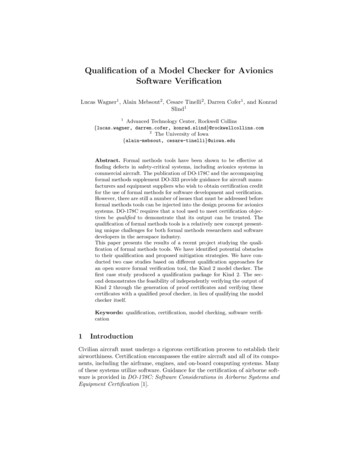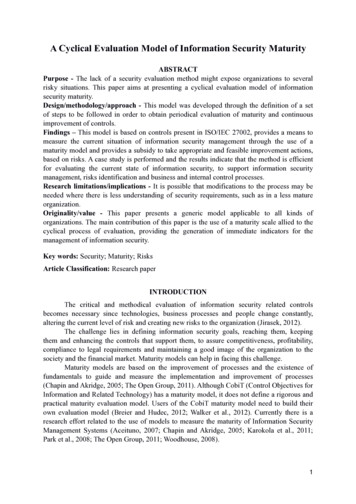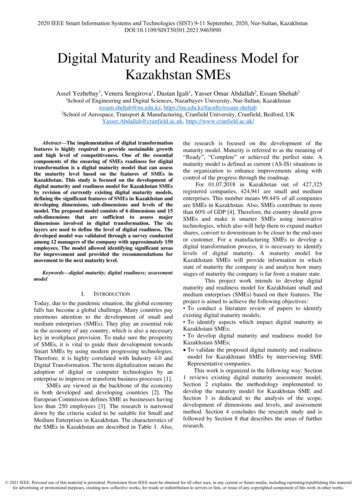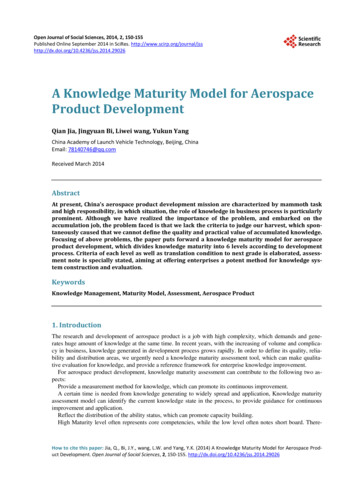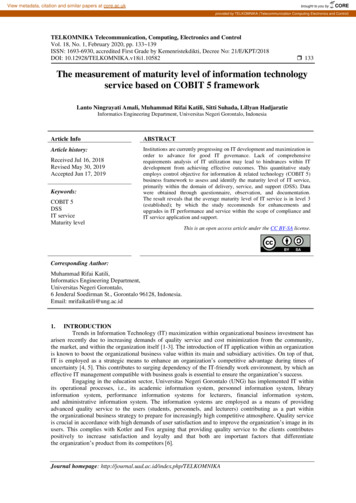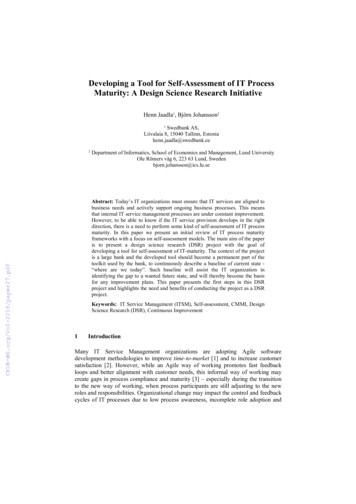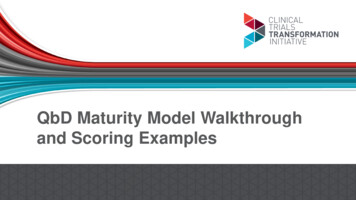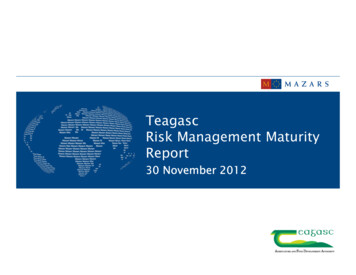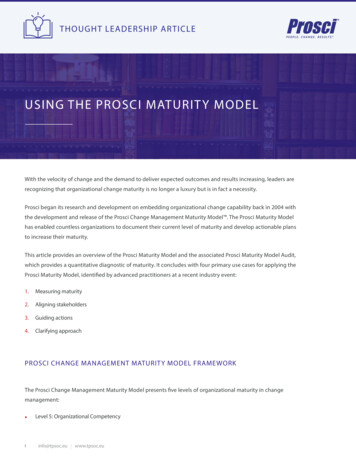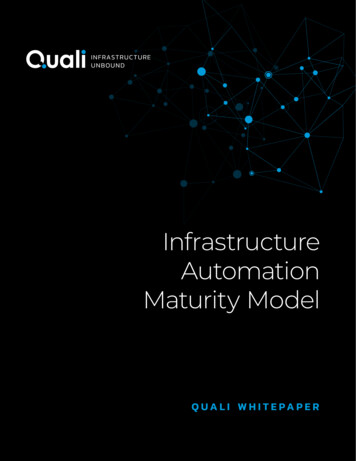
Transcription
InfrastructureAutomationMaturity ModelQ UA L I W H I T E PA P E R
TA B L E O F C O N T E N T SIntro3Infrastructure Automation Maturity Model4Infrastructure Level 1 - Ad-hoc5Infrastructure Level 2 - Automated6Infrastructure Level 3 - Frictionless7Infrastructure Level 4 - Lifecycle8Infrastructure Level 5 - Self-Defining9Using the Maturity model and next steps10About the Author/About Quali10Automation Maturity Model Quick Guide11Infrastructure Automation Maturity Model2
DevOps tools play a critical role in the delivery ofsoftware application services to businesses.Effective use of DevOps tools throughout thesoftware delivery lifecycle enables organizationsto respond to business requirements anddeliver change faster with greater agility.While DevOps objectives and value areunderstood, the way they are delivered differsfrom company to company, organization toorganization, and team to team. The idealDevOps state is acknowledged, but the realityfor enterprise organizations is that one sizedoes not fit all.Application architectures and business usecases always determine the IT stack required tosupport them and how they are managed. Theresult is a highly diverse set of IT infrastructurethat is used to support applications and thetools to deliver and manage them.This situation is exacerbated by freedom ofchoice. Infrastructure and tools differ betweenDevOps teams and throughout the softwaredelivery lifecycle. Teams gain significantexecution efficiencies when they are able tochoose their own tools. However, for enterprisesseeking to mature their DevOps practices,this choice also creates significant scale issuesespecially concerning costs, skills, and ITcomplexity.To address this, long established enterprisethinking of standardizing infrastructure andtools is regarded as a logical answer. Thisapproach is difficult as it requires agreementon common objectives which takes significanttime, effort, cost, control, and most importantly,a change in culture. For many enterpriseswith highly distributed business structures,standardization can only be achieved inlogical areas or locations.Solutions to scaling DevOps that introduceprocess bottlenecks, impede change, inhibitinnovation, slow business growth, and preventcompetitive differentiation are not going towork. The answer is enabling DevOps to maturenaturally, allowing teams to focus on increasingbusiness value. This is enabled through theadoption of modern management platformsthat allow infrastructure and tools choices to bemade while ensuring DevOps scale is managedand controlled without limitations.To guide this approach, Quali has developedthe Infrastructure Automation MaturityModelTM. Each level in the model describesinfrastructure automation value and the drivers,changes, and requirements to move to thehigher maturity levels.IT leaders and DevOps practitioners should usethe Infrastructure Automation Maturity ModelTMto assess their positioning and plot a strategyfor sequential improvement by investing in theplatforms and tools.The Infrastructure Automation MaturityModelTM provides enterprises a DevOps paththat answers the following questions: How do enterprise organizations scaleand evolve their DevOps practices, andhow will they be exploited to achievesoftware development excellence? How will enterprise organizations definetheir software delivery processes andmeasure them against business value?Infrastructure Automation Maturity Model3
I N F RASTRUC T U R E AU TO MATI O NMAT U R IT Y M O D E L T MThe Infrastructure Automation Maturity ModelTM is built around real-world factors to ensure eachlevel can be accurately assessed and measured. This includes the following assumptions:1. Applications determine the infrastructure and tools requirements2. Teams use whatever they want to deliver the product objectives3. Change is constant throughout the DevOps lifecycle4. Skills will differ between teams and throughout each DevOps process5. Infrastructure complexity will continue to increase6. Lifecycle means continuous delivery and planning to end-of-lifeInfrastructure management includes every activity required to deliver and manage infrastructurethroughout the entire lifecycle. The lifecycle is influenced by a number of factors and is measuredagainst required deliverables.Infrastructure Automation LIFECYCLEThe Infrastructure Automation Maturity ModelTM describes the attributes of four areas: culture,people, process, and technology. Each area is grouped with maturity progress against five levels ofmaturity: ad-hoc, automated, frictionless, lifecycle, and self-defining. Lastly, the end-to-end view ofthe 5-level model covers three maturity time zones. The time zones reflect the current, emerging,and horizon states.Infrastructure Automation Maturity Model4
I N F RASTRUC T U R E LE VE L 1 - AD-HOCAt Level 1, the enterprise infrastructure is a mix of old and new technology. The IT organizationis large, fragmented, and managing different parts of the infrastructure stack and flavors ofinfrastructure within each stack layer (e.g., servers, physical & virtual, on premise and cloud). ITteams are highly siloed with skills focused on domain areas including planning, development,testing, release, operations, and support. The provisioning of the infrastructure is accomplishedusing multiple methods and tools requiring highly-skilled personnel. Infrastructure change cantake time, create risk, and impact business services with increased change velocity—creatingsignificant challenges.LEVEL 1. Infrastructure challenges that need addressing:1. The rapid build of infrastructure (on premise/cloud)2. Teams use their tools with shareable content, reporting, and control3. Rapid change management promoting collaboration and mitigating creation/change risk4. Out-of-the-box support for the entire compute, network, storage, and softwareinfrastructure stack5. Existing methods and point tools evaluated with weaknesses identified and replaced toreduce complexity, optimize cost, and reduce riskInfrastructure challenges drivingmaturity from Level 1:Infrastructure Level 1AD - H OC5. Automating & integrating toolsCULTURE4. Infrastructure diversityPROCESS3. Agile adoption Uncommunicated objectives Infrastructure assumed Blind to complexity and cost Skilled practitioners Domain/function focus Measured against activityPEOPLE2. Establishing product teams Project to product Manual activities Manual create & configureTECHNOLOGY1. Execution speed Script-based tooling Manual activities Non-integratedInfrastructure Automation Maturity Model5
I N F RASTRUC T U R E LE VE L 2 - AUTOMATEDAt Level 2, the enterprise infrastructure remains a mix of new and old infrastructure stacks,however, cloud is rapidly adopted across the organization with agility and speed driving DevOpspractices to deliver change and new IT digital services to the business as efficiently as possible.The IT organization remains large and fragmentated due to the need to support legacy and newapplication architectures and business services. At thhis level, DevOps is emerging in different partsof the enterprise and teams are exercising their freedom of choice for infrastructure and tooling. Thiscreates massive IT infrastructure diverisity and an increasing demand for highly-skilled personnel.Level 2. Infrastructure challenges that need addressing:1. Intuitive interfaces, simple infrastructure visuals, guided execution and integration withcommand-level tools ensure all personnel at all skill levels can rapidly createand manage the infrastructure2. Cloud infrastructure costs captured and reported in real time ensures budgets are metand expenditures managed3. Infrastructure platform needs to provide out-of-the-box integration with allinfrastructure layers, in all locations, and with infrastructure task execution automatedto ensure additional workloads are scaled easily with full control4. Infrastructures created as code, managed by all DevOps team members at the levelthey need, in line with their skill level and infrastructure requirements5. Guardrails, intuitive interfaces, access controls, permissions, secure full-stack integration,and automated lifecycle governance from creation to retirement ensure risk is mitigatedand managedInfrastructure challenges drivingmaturity from Level 2:Infrastructure Level 2AU TO MATE D5. Execution riskCULTURE4. Increasing skills & complexityPROCESS3. Increased workloads Reduce complexity Reduce execution time Remove manual activity Highly-skilled practitioners Teams with broader functions Measured against throughputPEOPLE2. Unplanned costs (cloud) DevOps/shift-left established Mixed/Hybrid Clouds Silo process activity deliveryTECHNOLOGY1. Scale (skills, complexity) Sophisticated/custom Team automation & integration Tools choice freedomInfrastructure Automation Maturity Model6
I N F RASTRUC T U R E LE VE L 3 - FRIC TIONLESSAt Level 3, enterprises are driven by the need to deliver rapid changes while ensuring risk ismanaged. Optimization becomes a key initiative. The need to standardize, reduce complexity,and gain visibility into costs must be addressed to understand how to measure DevOps activitiesand value to the business. Without a control over infrastructure complexity, there are significantimpacts to an enterprise’s ability to scale. Too many tools, too much time wasted, risks associatedwith change, and the ongoing need to hire scarce and high-cost skilled personnel take a toll andrequire a solution that makes the infrastructure invisible—easily and safely created, delivered andused without it being intrusive and detrimental to execution.LEVEL 3. Infrastructure challenges that need addressing:1. Each infrastructure instance created on-demand by a team or team member ensuringit’s associated with an owner, delivered and governed without human interaction—delivering a safe “create and forget” capability2. Change accomplished with minimum effort and risk ensuring DevOps teams canfocus on their role priorities and not on the complexities associated with managing theinfrastructure3. Infrastructure modeling ensures the infrastructure lifecycle is automatically managedwhether for one stage of a DevOps process or shared across the entire DevOps lifecycle4. Infrastructure usage and state are managed, ensuring they are optimized andautomatically removed when no longer needed, saving effort and cost5. Critical business infrastructures understood and managed with the same simplicity assmaller lab, test, or development environmentsInfrastructure challenges drivingmaturity from Level 3:Infrastructure Level 3F R I C TI O N LE SS5. Infrastructure change prioritiesCULTURE4. Resource optimizationPROCESS3. Infrastructure lifecycle management Self-service without risk Increasing workloads Change instances managed Skills focused where needed Skills optimized and leveraged Measured against productivityPEOPLE2. Infrastructure & DevOpsinfrastructure change DevOps scaled and optimized Full stack process managed End-to-end process visibilityTECHNOLOGY1. Accountability & governance Low/no touch requirement Infrastructure agnostic at scale Intuitive simple UXInfrastructure Automation Maturity Model7
I N F RASTRUC T U R E LE VE L 4 - LIFECYCLEModern software development practices must be used with full governance, security, and changecontrol. Innovation remains a primary objective but not at the expense of cost and negativeimpacts to the business and company reputation. Infrastructures must be optimized, hardened(reliable/proven), controlled, and accountable to the value delivered. Infrastructures are managedholistically end-to-end, from plan to production and not a fragmented practice split across eachDevOps team function. Efficient infrastructure management becomes a business differentiator.LEVEL 4. Infrastructure challenges that need addressing:1. Infrastructure lifecycle costs are understood, controlled, and managed in line withbudget and expected ROI2. Business value created by ensuring the end-to-end DevOps lifecycle infrastructuremanagement delivers to the business what was planned at the beginning ofthe process3. An established single source of truth for infrastructure control allows each DevOps teamor team member to leverage the infrastructure throughout the process4. DevOps teams understand and leverage other DevOps teams infrastructure modelsdelivered at scale saving time, effort, and cost Infrastructures in the Dev side automatically moved safely to the Ops side,significantly reducing the gap and time between ‘commit’ and production6. The library of proven/active infrastructure models (blueprints) combined with the dataon usage and results allows infrastructures delivered to be trusted, known and provenInfrastructure challenges drivingmaturity from Level 4:Infrastructure Level 4LI F ECYC LE5. Infrastructure change predictionCULTURE4. Infrastructure real-time observabilityPROCESS3. Organizational priorities Governance required Accountability measured End-to-end change managed Cross-team prioritization Cross-team optimization Measured against outputsPEOPLE2. Infrastructure value to business DevSec Ops & Dev Value Streams End-to-end execution & visibility Infra. & DevOps infra. lifecycle mgt.TECHNOLOGY1. Cost transparent & managed End-to-end management platform Integrated/automated change End-to-end change & risk mgd.Infrastructure Automation Maturity Model8
I N F RASTRUC T U R E LE VE L 5 - SELF-DEFININGModern Infrastructure as Code architectures are intelligent, providing support to the businessthrough constant evaluation, automatic enhancements, and cost-effective use with continualfeedback showing business value. The management of the infrastructure no longer requireshighly-skilled resources and is treated as a high-scale, end-to-end subliminal activity supportingand enhancing the software delivery value streams.LEVEL 5. Infrastructure challenges that need addressing:1. Infrastructure provisioned and managed as defined by the application (infrastructureadded, changed, tracked, and removed dynamically and upon instruction)2. Infrastructure adapts in line with application use (performance, capacity, location, cost)3. Infrastructure as Code mesh supporting many highly distributed, business applicationarchitectures, changing the infrastructure as usage dictates4. Using data collected and analyzed by the infrastructure automation platform, dynamicchanges are recommended or automatically made in support of infrastructureoptimization, performance, cost, and efficiency5. Infrastructure usage data collected and analyzed with changes automatically madeto the library of infrastructure models (blueprints) ensuring continuous infrastructureimprovements are made to deliver immediate benefits to the businessInfrastructure challenges drivingmaturity from Level 5:Infrastructure Level 5S E LF - D E F I N I N G5. Continuous feedback/improvementCULTURE4. Environment delivered not developedPROCESS3. Dynamic enterprise optimization Costs managed Business outcome measured Complete observability Business-driven contribution Cross-team business priorities Measured against outcomesPEOPLE2. Usage dynamically adapted Business Value Streams End-to-end value context Seamless DevOps/infra processTECHNOLOGY1. Application change-driven infrastructure Dynamic lifecycle Intelligent predictive change Single source of truthInfrastructure Automation Maturity Model9
U S I N G TH E MAT U R IT Y M O D E L AN D N EX T STE P S Infrastructure challenges that need addressing:1. Create an infrastructure management strategy2. Understand current IT infrastructure practices and how they enable, challenge or inhibitcurrent and future IT and business objectives3. Assess how infrastructure is managed and map it against an established desired state4. Establish a maturity path that meets the needs of applications today and into the future5. Measure progress and make decisions against the strategic infrastructure AUTOMATIONROIABO U T TH E AU TH O R :David Williams VP Product Strategy, QualiDavid Williams leads Quali’s Product Strategy and brings with him extensiveexperience successfully establishing, focusing and growing start-ups. David possessesexceptional managerial abilities, be it in handling small, dedicated teams or largedistributed teams. Apart from growing revenues for established IT companies, Davidhas had diverse experience in Product Management and Marketing. With over twohundred research papers and published articles, David has delivered numerous keynotes andpresentations at leading industry events worldwide, on a wide range of IT management subjects.Quali provides the leading platform for Infrastructure Automation at Scale. Global 2000 enterprisesand innovators everywhere rely on Quali’s award-winning CloudShell and Torque platforms tocreate self-service, on-demand automation solutions that increase engineering productivity, cutcloud costs, and optimize infrastructure utilization.Learn more at QUALI.comInfrastructure Automation Maturity Model10
CULTUREPROCESSQUICK GUIDE Skilled practitioners Domain/function focus Measured against activityPEOPLEI N F RASTRUC T U R ELE VE L S Uncommunicated objectives Infrastructure assumed Blind to complexity and cost Project to product Manual activities Manual create & configureTECHNOLOGYInfrastructure Level 1AD - H OC Script-based tooling Manual activities Non-integratedInfrastructure Level 2AU TO MATE DCULTURE Reduce complexity Reduce execution time Remove manual activityCULTURE Self-service without risk Increasing workloads Change instances managedPROCESS Highly-skilled practitioners Teams with broader functions Measured against throughputPROCESS Skills focused where needed Skills optimized and leveraged Measured against productivityPEOPLE DevOps/shift-left established Mixed/Hybrid Clouds Silo process activity deliveryPEOPLE DevOps scaled and optimized Full stack process managed End-to-end process visibilityTECHNOLOGY Sophisticated/custom Team automation & integration Tools choice freedomTECHNOLOGYInfrastructure Level 3F R I C TI O N LE SS Low/no touch requirement Infrastructure agnostic at scale Intuitive simple UXCULTURE Governance required Accountability measured End-to-end change managedCULTURE Costs managed Business outcome measured Complete observabilityPROCESS Cross-team prioritization Cross-team optimization Measured against outputsPROCESS Business-driven contribution Cross-team business priorities Measured against outcomesPEOPLE DevSec Ops & Dev Value Streams End-to-end execution & visibility Infra. & DevOps infra. lifecycle mgt.PEOPLE Business Value Streams End-to-end value context Seamless DevOps/infra process End-to-end management platform Integrated/automated change End-to-end change & risk mgd.TECHNOLOGYInfrastructure Level 5S E LF - D E F I N I N GTECHNOLOGYInfrastructure Level 4L I F E CYC LE Dynamic lifecycle Intelligent predictive change Single source of truthInfrastructure Automation Maturity ModelInformation in this document is accurate as of 05/21/2021. Information may have changed after this date.11052121 v1
The Infrastructure Automation Maturity ModelTM describes the attributes of four areas: culture, people, process, and technology. Each area is grouped with maturity progress against five levels of maturity: ad-hoc, automated, frictionless, lifecycle, and self-defining. Lastly, the end-to-end view of the 5-level model covers three maturity time .
